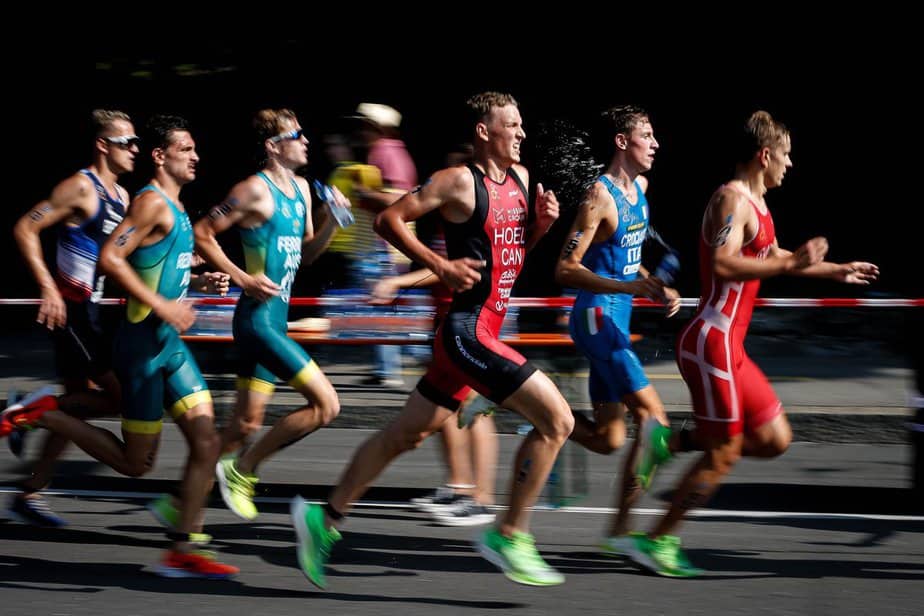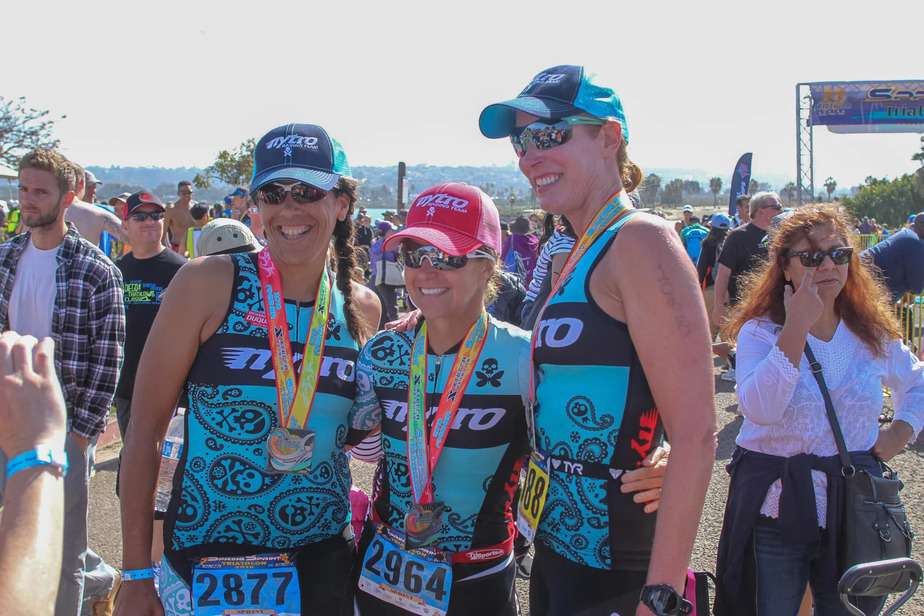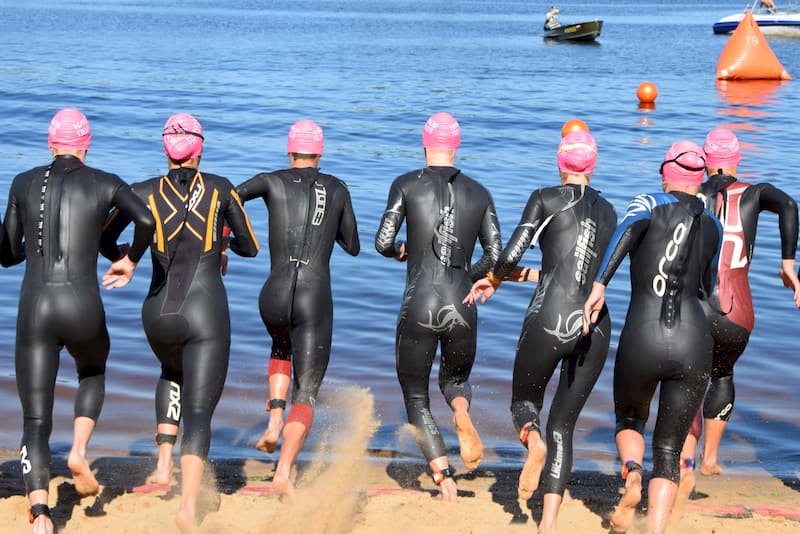If you or a friend have been thinking about doing a triathlon, you might be wondering what distance to do. We’re going to walk you through each of the triathlon distances, who does them, how long it takes and how to approach them.

Triathlon Distances in Miles (and Kilometres)
| TRIATHLON DISTANCE | SWIM DISTANCE | BIKE DISTANCE | RUN DISTANCE | AVERAGE PARTICIPANT FINISH TIME |
|---|---|---|---|---|
| Super Sprint | 0.25mi (400m) | 6.2mi (10km) | 1.5mi (2.5km) | 0:30-1:00 |
| Sprint | 0.5mi (750m) | 12.4mi (20km) | 3.1mi (5km) | 1:10-1:45 |
| Olympic / 5150 | 0.93mi (1.5km) | 24.8mi (40km) | 6.2mi (10km) | 2:20-3:25 |
| Half Ironman / 70.3 | 1.2mi (1.9km) | 56mi (90km) | 13.1mi (21.1km) | 4:50-6:40 |
| Ironman / 140.6 | 2.4mi (3.8km) | 112mi (180km) | 26.2mi (42.2km) | 9:30-14:00 |
How Long is a Triathlon?
1. Super Sprint Triathlon Distance
Swim: 400m
Bike: 10km
Run: 2.5km
(Distances may vary)
Average finish times: 0.5-1 hour
How much time will you need to train: 3-4 hours per week.
The shortest distance, which a lot of people start out with is called the super sprint or it might be called the try-a-tri. These races are really, really short, like really short. The super sprint only takes in between about 40 and 60 minutes.
The distances for this vary a lot depending on the course, but typically they’re in the neighborhood of around 400 meters for the swim, about 10 kilometers for the bike and about 2.5 kilometers for the run. It’s an excellent way to get into triathlon.
If you’re starting from no athletic background at all I would definitely recommend starting with one of these types of races.
2. Sprint Triathlon Distance

Swim: 750 meters
Bike: 20km
Run: 5km
Average finish times: 1-3 hours
How much time will you need to train: 3-5 hours per week.
The next longest distance is called the sprint triathlon. Sprints are still short, but they’re normal short. This is a 750 meters swim, a 20 km bike and a 5 km run. Pro triathletes are doing this in around 52 minutes.
The average age group athlete might take about an hour and 20 minutes to an hour 30 minutes, going up to about two hours.
This is a very good distance to start out with as well because it’s over fairly quickly, you never get too far away from the finish lines so there’s always people to help you if you need. If you’re thinking about becoming a more competitive age group triathlete, Sprint triathlon is a very good place to build your speed from.
You don’t have to worry a ton about nutrition in sprint triathlons. This distance is nothing to sneeze at, it’s a very difficult race to do because it is so quick, your lactic acid really builds up in your body. Youth triathletes actually race this distance and if you see the looks on their faces you know that this is no cakewalk.
3. Olympic Triathlon Distance
Swim: 1.5km
Bike: 40km
Run: 10km
Average finish times: 2-4 hours
How much time will you need to train: 4-7 hours per week.
The next longest distance is an Olympic triathlon. Olympics just seems kind of like a normal distance for many triathletes.
Olympic triathlon is 1500 meters swim, a 40 km bike, and then a 10 km run. This is what you see in, fittingly, the Olympics. Pro triathletes are doing these in about an hour and 49 minutes.
The average age group athlete might do it in about two hours and 40 minutes going all the way up to 3.45, almost four hours in some cases.
An Olympic distance triathlon is still not a bad place to get started in the sport, because an Olympic distance triathlon is getting a little bit longer than those short distances, you do have to worry about things like nutrition, proper pacing, your race strategy, whether you go harder in one sport or another.
But then the nice thing about the Olympic distance triathlon is that your body has a lot of time to settle into each sport.
In some cases, let’s say you get off the bike and you’re not feeling very well and your body’s cramping as you start to run, you’ve got enough time to turn that around and actually have a really good run if you can settle your body down and get into a nice pace.
There’s the opportunity for disaster, but also the opportunity to fix problems if they come up. This distance triathlon is certainly one that you have to train for, it’s a lot harder just to go and enter it without training at all. But it’s right on the edge of being able to get through it coming in cold.
4. Half Ironman Triathlon Distance
Swim: 1.9km (1.2 miles)
Bike: 90km (56 miles)
Run: 21km (13.1 miles)
Average finish times: 4-8 hours
How much time will you need to train: 7-13 hours per week.
Total distance for a half is a 1900 meter swim, a 90 km bike and then a half marathon, 21.1 kilometers. Pro triathletes will be doing half triathlon in about three hours and 45 minutes. Age group athletes can take probably in between about five and six hours on average. This is where cut-off time starts coming into play.
You have an hour and 10 minutes to finish the swim, five and a half hours past the start of the race to finish the bike and eight and a half hours past the start of the race to finish the entire race. That’s very generous and not a lot of people should ever have an issue coming into that cutoff time.
This is a distance of triathlon where you really have to worry about the preparation before you get to the start line.
A lot of people absolutely love the half distance. They say that it’s their favorite distance of triathlon. It’s probably the longest distance that you can go and still make it a race.
It’s not nearly as acutely painful as the sprint and Olympic races, it’s painful in a different way, more in the aspect of managing your body, making sure that you don’t beat yourself down.
But it’s about as long as you can go in a race effort while still incorporating some of the logistical issues of nutrition and training and strategy. It’s fun in a sick and twisted way.
5. Ironman Triathlon Distance
Swim: 3.9km (2.4 miles)
Bike: 180km (112 miles)
Run: 42.2km (26.2 miles)
Average finish times: 8-17 hours
How much time will you need to train: 12-20 hours per week.
The granddaddy of them all which has inspired many an M-Dot tattoo is the full distance race.
This a 3.8 kilometers swim, a 180 kilometers bike and a full marathon, 42.2 kilometers run. It’s horrible, just a horrible distance.
Pro triathletes are now doing this distance in as quickly as seven hours and 45 minutes, and the longest amount of time that you can take because you get booted off the course if you don’t finish it by midnight, is 17 hours.
That’s right, some people are doing a triathlon in the entire amount of time that most of you are awake throughout the day.
This varies a little bit from race to race, but age group athletes are giving about two hours and 10 minutes to complete the swim, about eight hours and 10 minutes to complete the bike and about six hours and 30 minutes to complete the marathon.
6. Ultratriathlon Distance
A double ultra triathlon, a triple ultra triathlon, quadruple ultra triathlon, a quintuple ultra triathlon, a deca ultra triathlon, a 10 days triathlon, a double deca ultra triathlon and a triple deca ultra triathlon.
These races are really far. I’m going to tell you about the triple deca ultra triathlon. It’s a 114 km swim / 71 miles, a 5400 km / 3400 miles bike ride, and a 1260 km / 780 mile of run.
What is the Best Triathlon Distance for You?

Which is your strength? All triathletes are endurance athletes, but races can range from sprint triathlons of about an hour to Ironman efforts for up to 17!
Do you cope well with the sensation of lactic burn and prefer to have it over with quickly, or would you rather stretch your effort out over hours with less intensity? My recommendation is to try everything, but then go with your strength and develop it to the max.
Pure sprinters don’t even use their aerobic systems on race day. Their performance is determined by power and top-end speed in events of 30 seconds or less. Middle distance athletes use a combination of both their aerobic (with oxygen) and anaerobic (without oxygen) systems in events of up to several minutes.
Beyond that it’s all aerobic except for an anaerobic burst to get over a short hill, close a gap, or sprint at the end of a race.
Endurance events like triathlon favor athletes with a predominant percentage of slow twitch muscle fibers, fibers that are efficient at relatively low aerobic energy levels. Fast twitch fibers work best for pure speed but can be converted to work as slow twitch fibers do with endurance work.
Athletes who do best at endurance events will have greater than 50% slow twitch fibers, and in some cases near 100%. The trade off is that they have no sprint at the end of a race, not much of a handicap for triathlon.
Body type makes a difference as well and typically muscle type is in sync. Usually predominantly slow twitch types have medium to small builds; usually fast twitch types have medium to large builds.
If you’re not sure, look at the athlete’s wrist to determine body type by bone structure. No matter how much weight training one does, you can’t increase the size of your wrist; it’s all bone and tendon. To a lesser extent you can determine bone structure by ankle size.
For any endurance athlete, regardless of build or muscle type, an efficient power to weight ratio is always a good thing! This means a low percentage of body fat as measured by a body composition test.
Running speed is in a large part gravity dependent. Aerobic efficiency determines how much energy your muscles develop out over time, and in turn the strength of each muscle contraction determines speed potential, and finally the distance you travel with each stride will be limited by your weight.
All else remaining equal, the lighter you are, the further you’ll move with each stride. This is why most elite distance runners are relative flyweights.
Athletes who excel at sprint and Olympic distance are able to hold a very high percentage of their max HR for 1-2.5 hours, usually in the 85 to 93% of max range. They’re keeping the effort level near ‘redline’ from start to finish.
Athletes who do well at Half-Ironman distances (the ‘middle distance’ of triathlon) maintain a HR range of 75 to 85% for 4 to 7 hours. Athletes who do well at full IM distances maintain a range of 65 to 75%HR which is similar to relatively comfortable training levels for shorter workouts, but holding that pace for 8 to 16+ hours!
The Sprint/Olympic distance athletes cope with the sensation of with lactic burn; IM athletes cope with soreness and overall fatigue. IM athletes are also limited by the efficiency of their metabolism. Some athletes struggle with this despite a perfect nutritional plan on race day while some seem to have no problem.
A well trained athlete can store enough calories (glycogen) to carry them through 2-2.5 hours of high intensity work without absorbing calories during the event. The IM athlete needs an efficient metabolism that burns a high percentage of fat along with glycogen, and also absorbs calories during the event.
Every athlete I’ve coached eventually learns what his or her best distance is. It doesn’t mean they can’t do well at other distances, but they may never excel at those distances. The psychological component counts for a lot. Good experiences at a certain distance lead to confidence that builds over time.
Are your sprint to Ironman performances of equivalent quality, or are your PRs better at one distance than another? Take your PR on an accurately measured Olympic distance course and multiply it by 4.6-4.7 for Ironman time potential. Take your ½ Ironman PR and multiply x 2.2-2.25 for Ironman potential. These ratios assume the same degree of difficulty for the course and similar environmental conditions (hilly, flat, cool day, hot day, etc.).
It’s a rare athlete who can compete equally well at all distances. I can think of only a few athletes (Mark Allen, Chris McCormack, Jan Frodeno and Kristian Blummenfelt) who’ve won World Championships at both Olympic Distance and Ironman, quite an accomplishment indeed!
I have a long way to go with my training. I am 62 year old now, and trying to find my fountain of youth. Have no douth about doing an Ironman. Form Airborne Ranger!